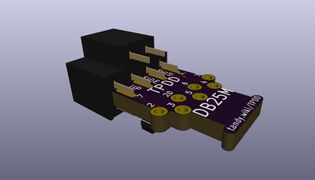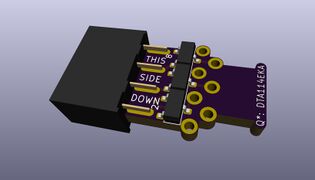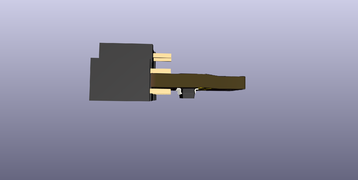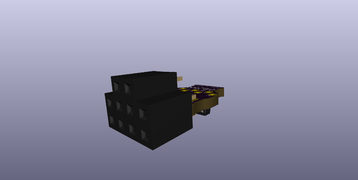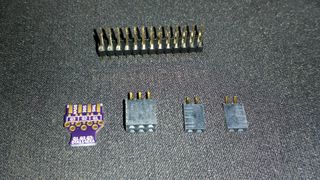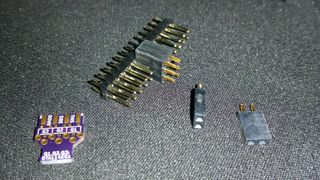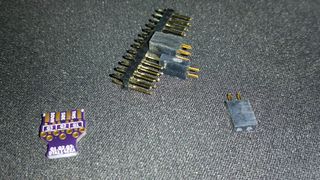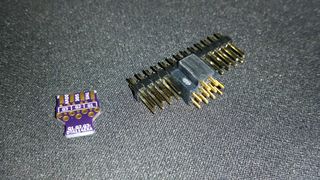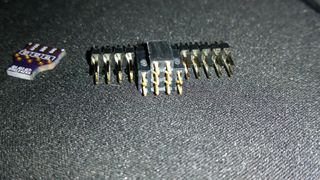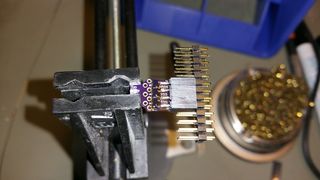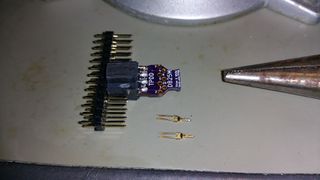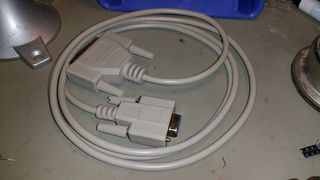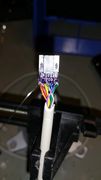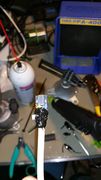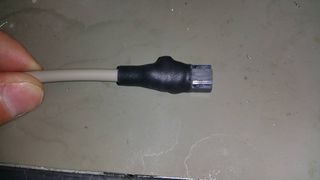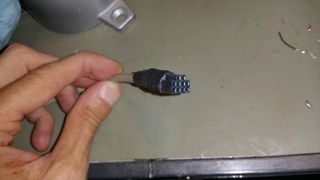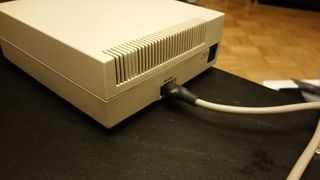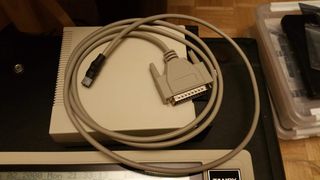TPDD: Difference between revisions
(→Cable) |
(→Cable) |
||
| Line 58: | Line 58: | ||
:8 EB+ (External Battery +4.8 to +6v) | :8 EB+ (External Battery +4.8 to +6v) | ||
KiCAD source for schematic & pcb to build a cable | [https://github.com/bkw777/TPDD_Cable KiCAD source for schematic & pcb to build a cable] | ||
The only difference between these 3 versions of the PCB is the silkscreen.<br> | |||
Each version has the through holes for soldering the wires labelled with numbers specifically for that cable's type of plug and pinout.<br> | |||
The only difference in the BOM links is the plugs on the included serial cable.<br> | |||
The standard cable requires a cable with a 25-pin female plug one one end, and the other end doesn't matter, it's cut off and discarded.<br> | |||
The Z88 cable requires a cable with a 9-pin male plug.<br> | |||
The cable for WP-2 and most PC's requires a cable with a 9-pin female plug.<br> | |||
All other parts are the same. | |||
{|class="wikitable" style="text-align: center;" | {|class="wikitable" style="text-align: center;" | ||
Revision as of 03:00, 23 September 2020
Tandy Portable Disk Drive
There were two versions of the Tandy Portable Disk Drive, "26-3808 Tandy Portable Disk Drive" or "TPDD1", and "26-3814 Tandy Portable Disk Drive 2" or "TPDD2". Both were very similar. The original TPDD1 is a re-branded Brother FB-100.
Common features of both versions
- Size, shape, weight
- Batteris: 4 x AA
- Wall power: 5.5mm x 2.1mm, 6vdc, center negative, 400ma (Tandy 26-3804)
- Media: 3.5" DD, aka "720K" diskettes (not HD 1.44M)
- Drive is single-sided. The disks may be single or double-sided, but the drive only uses one side.
Documentation
Tandy Portable Disk Drive
100K
Tandy Portable Disk Drive 2
200K in the form of 2 100K banks (still only uses one side of the disk)
Parts
Belt
Standard size code: FRW-8.5
Search "FRW 8.5 belt" on Google or ebay
Cable
The "RS-232C" interface to the TPDD is actually 5v TTL (0v to +5v), while RS-232 serial ports use -12v to +12v. So the cable isn't just a cable, it has electronics inside the DB25 plug to convert the signal levels between TTL and RS-232.
Pinout
+------------------------------------------------+ | | | | | RS-232C | | ___ | | +--+ +--+ +-----+ | | | 7 5 3 1 | | (o) | | | | 8 6 4 2 | | | | | +---------+ +-----+ | +------------------------------------------------+
- 1 GND
- 2 CTS
- 3 DTR
- 4 RTS
- 5 DSR
- 6 TXD
- 7 RXD
- 8 EB+ (External Battery +4.8 to +6v)
KiCAD source for schematic & pcb to build a cable
The only difference between these 3 versions of the PCB is the silkscreen.
Each version has the through holes for soldering the wires labelled with numbers specifically for that cable's type of plug and pinout.
The only difference in the BOM links is the plugs on the included serial cable.
The standard cable requires a cable with a 25-pin female plug one one end, and the other end doesn't matter, it's cut off and discarded.
The Z88 cable requires a cable with a 9-pin male plug.
The cable for WP-2 and most PC's requires a cable with a 9-pin female plug.
All other parts are the same.
| For use with any "Model T" | For use with TANDY WP-2 and most PC's | For use with Cambridge Z88 |
|---|---|---|
| PCB | PCB | PCB |
| BOM (black cable) | Any of the other BOM links will work for this. They all include a cable with a DE9F on one end. |
BOM (black cable) |
- Assembly:
- Solder all components to pcb per the render pics.
- Pull the two un-soldered pins from the top of the socket and discard.
- Cut the 9-pin plug off the serial cable. Strip the outer sheath back 1 to 2 inches. Strip each wire 1/8".
- Put 2 to 3 inches of 1/2" diameter heat shrink on the serial cable. (don't shrink yet)
- Identify which color wires go to which pins on the DB25 plug.
- Find pin 2 on the db25
- Find which color wire goes to pin 2 using a DMM continuity tester
- Repeat for all the numbered holes on the PCB: 2,3,4,5,6,7,20
- Cut any left-over wires short right at the cable sheath.
- Solder the wires to their matching numbered holes, with the wires on the top side (without the transistors).
- Put some hot-glue on the top side of the pcb in the "dog bone", press the end of the cable into the glue, and secure to the pcb with a zip-tie.
- Add some hot-glue around the soldered wires where they meet the pcb to immobilize them.
- Slide the heat-shrink up over the pcb and shrink.
Software
For PCs
TPDD used double density 3.5" disks, but used a format that is incompatible with modern pc drive controllers. Normal MS-DOS formatted disks are written with MFM encoding, while the TPDD used FM encoding. Even using special software to read non-standard formats, you can't make a normal drive & drive controller read or write FM.
To read or write a TPDD disk from a modern machine, you need a working TPDD drive and the special RS232-to-TTL level-shifting serial cable that came with it, and a "TPDD Client" software to talk to the drive over the serial connection the same way the M100 does.
There are several TPDD clients for more modern machines. Most of these are themselves also no longer modern. For example Lap-Desk and PDD are both 16-bit DOS programs that don't work on Windows.
TpddTool Python TPDD Client
There are several TPDD_Emulators, which are programs that run on a host pc, that don't *use* a TPDD, but they emulate *being* a TPDD, so a Model 100, 102, 200, WP-2, NEC PC-8201, PC-8201a, PC-8300, Kyotronic KC-85, Olivetti M-10, can save and retieve files on a modern computer.
For M100/102/200
The normal way to use a TPDD is to install a "dos" or TPDD_client on an M100. Several such dos's have been made. The drive came with a utility disk and a functional dos called "floppy". Others have been made by 3rd parties that provided more features or smaller ram footprint or more flexible installation/usage. There are also various special purpose utility programs aside from dos's.
